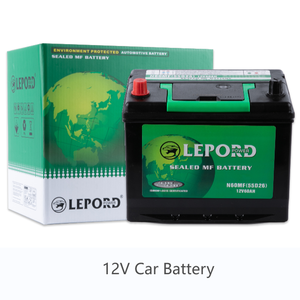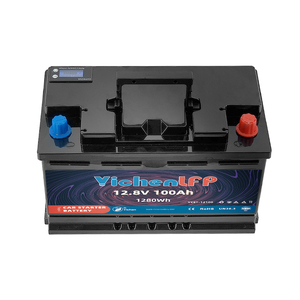Types of 80 Amp Car Batteries
An 80 amp car battery refers to a battery with 80 amp hours capacity. This means it can deliver a current of 80 amps for one hour or 40 amps for two hours before being discharged. These batteries are commonly used in vehicles with high energy demands such as trucks and buses, or applications requiring deep cycling capabilities.
Expert Tip: When choosing between battery types, consider not only the initial cost but also the total cost of ownership including expected lifespan and maintenance requirements.
Lead-acid Batteries
The oldest and most common type of 80-amp car battery, featuring electrodes made of lead and lead dioxide immersed in a sulfuric acid electrolyte solution.
Advantages: Reliable, cost-effective, easy to manufacture
Limitations: Requires regular maintenance, less efficient than newer technologies
Lithium-ion Batteries
The newest technology in 80-amp car batteries, gaining popularity due to their superior performance characteristics.
Advantages: High energy density, lightweight, low self-discharge rate
Limitations: More expensive than other options, may require special charging systems
AGM Batteries
A specialized lead-acid battery using glass mats to absorb the electrolyte, making them spill-proof and vibration-resistant.
Advantages: Maintenance-free, low self-discharge, high current delivery
Limitations: More expensive than traditional lead-acid, sensitive to overcharging
Gel Batteries
Another lead-acid variant using a gel electrolyte instead of liquid, offering improved durability and versatility.
Advantages: Spill-proof, corrosion-resistant, maintenance-free
Limitations: Premium price point, specific charging requirements
| Battery Type | Lifespan | Maintenance | Cost | Best Application |
|---|---|---|---|---|
| Lead-acid | 3-5 years | Regular | $ | General automotive use |
| Lithium-ion | 8-10 years | Minimal | $$$ | Electric vehicles, high-performance applications |
| AGM | 4-7 years | Low | $$ | Start-stop systems, vehicles with high electrical demands |
| Gel | 5-8 years | Low | $$ | Marine applications, deep cycle needs |
Specifications of 80 Amp Car Batteries
Understanding the key specifications of 80 amp car batteries is essential for selecting the right battery for your needs. These specifications determine performance, compatibility, and longevity.
Capacity (80 Amp Hours)
Indicates how much power the battery can supply and for how long. An 80 amp-hour battery can deliver 80 amps for one hour or 40 amps for two hours. This capacity is ideal for powering essential vehicle components, including the ignition system and various electrical accessories.
Cold Cranking Amps (CCA)
Measures the maximum current a battery can provide at 0°F for 30 seconds while maintaining at least 7.2 volts. For 80 amp batteries, CCA typically ranges from 400 to 600 amps, ensuring reliable engine starting even in cold weather conditions.
Voltage (12V)
Most 80 amp car batteries operate on a standard 12-volt system, powering the vehicle's electrical components and starting the engine. Voltage stability ensures smooth operation of electronic systems like radios, GPS units, and fuel injection systems.
Size and Weight
Available in various dimensions to fit different vehicles. Typically range from 10-12 inches in length, 7-9 inches in width, and 7-8 inches in height. The battery's physical size affects installation compatibility with vehicle battery trays and hold-downs.
Terminal Type
80 amp batteries come with different terminal configurations including top-post and side-post options. Terminal sizes typically range from 0.75 to 1.5 inches in diameter, accommodating various cable sizes and connection requirements.
Reserve Capacity (RC)
Measures how many minutes a battery can deliver 25 amps while maintaining at least 10.5 volts. Higher RC ratings indicate better battery performance during alternator failure scenarios.
Maintenance of 80 Amp Car Batteries
Proper maintenance is crucial for maximizing the lifespan and performance of your 80 amp car battery. Following these maintenance procedures can help prevent premature failure and ensure reliable operation.
Preventive Maintenance Tip: Test your battery's voltage every 3 months using a multimeter. A healthy 12V battery should read between 12.4-12.7V when fully charged. Readings below 12.4V indicate it's time for a recharge.
| Maintenance Task | Frequency | Tools Required | Importance |
|---|---|---|---|
| Terminal Cleaning | Every 3 months | Baking soda, water, brush, wrench | High |
| Connection Tightening | Every 3 months | Wrench, socket set | Critical |
| Visual Inspection | Monthly | None | Medium |
| Voltage Testing | Quarterly | Multimeter | High |
| Electrolyte Level Check (for serviceable batteries) | Monthly | Safety gear, distilled water | High |
Essential Maintenance Procedures
1. Regular Cleaning
Clean terminals and connections using a solution of baking soda and water to remove corrosion. This improves electrical conductivity and prevents voltage drops. Use a soft brush for cleaning to avoid damaging terminal surfaces.
2. Tight Connections
Inspect terminals periodically to ensure tight connections. Loose terminals can cause voltage drops and potentially damage the battery. Use a wrench to tighten connections, but avoid overtightening which can damage terminal posts.
3. Equalization
For multi-cell batteries, perform periodic equalization charging to ensure all cells maintain the same charge level. This involves charging the battery at a slightly higher voltage for a specific period following manufacturer guidelines.
4. Proper Storage
When not in use, store batteries in a cool, dry place away from extreme temperatures, moisture, and direct sunlight. Use a battery maintainer for long-term storage to prevent self-discharge and sulfation.
How to Choose 80 Amp Car Batteries
Selecting the right 80 amp car battery requires consideration of several important factors to ensure compatibility, performance, and value. Whether for personal use or retail business, these selection criteria will guide you to the optimal choice.
Selection Tip: Always cross-reference your vehicle's manual specifications before purchasing a new battery. Vehicle manufacturers often specify recommended CCA ratings and battery dimensions that ensure optimal performance.
Cold Cranking Amps (CCA)
A crucial metric measuring starting power at cold temperatures. Higher CCA ratings (400-600 amps for 80 amp batteries) provide better cold-weather performance. Vehicles in colder climates benefit from higher CCA ratings.
Reserve Capacity (RC)
Indicates how long the battery can power essential systems during alternator failure. Higher RC ratings provide extended backup power, beneficial for vehicles with numerous electronic accessories or those frequently driven in remote areas.
Size and Fit
Vehicles are designed for specific battery dimensions. Measure the old battery and select a replacement with matching dimensions. Also ensure the correct terminal configuration (top-post or side-post) for your vehicle.
Temperature Tolerance
Consider local climate conditions when selecting a battery. AGM and Gel batteries typically offer better performance in extreme temperatures compared to conventional lead-acid batteries.
Deep Cycle vs. Starting Batteries
Starting batteries deliver high current for short durations, ideal for automotive applications. Deep cycle batteries are designed for sustained power delivery, better suited for RVs, boats, or applications requiring consistent power over time.
Brand Reputation and Warranty
Quality varies between manufacturers. Reputable brands often offer longer warranties and more reliable performance. Consider warranty terms as an indicator of expected battery life and manufacturer confidence.
Starting Battery Needs
For vehicles primarily used for regular commuting with standard electrical equipment:
- Prioritize CCA rating appropriate for your climate
- Standard 80 amp-hour capacity is generally sufficient
- Consider maintenance-free options for convenience
High-Performance Needs
For vehicles with advanced electronics, aftermarket audio, or performance modifications:
- Look for higher Reserve Capacity
- Consider AGM or Lithium-ion technologies
- May benefit from dual battery setups
Commercial/Fleet Applications
For trucks, buses, and commercial vehicles:
- Emphasize durability and cycle life
- Higher CCA ratings for consistent starting
- Consider total cost of ownership over purchase price
How to DIY and Replace 80 Amp Car Batteries
Replacing an 80 amp car battery is a straightforward DIY task that can save you money and time. With the right tools and following proper safety procedures, you can complete this job in approximately 30 minutes.
Required Tools
- Wrench or socket set (10mm or 13mm typically)
- Battery terminal puller (optional but helpful)
- New 80 amp-hour battery
- Battery cleaning brush or terminal cleaner
- Protective gloves and safety glasses
- Baking soda and water solution (for cleaning)
Safety Tip: Always disconnect the negative terminal first and reconnect it last to prevent short circuits. This simple practice significantly reduces the risk of sparks and potential battery damage.
Step-by-Step Replacement Guide
Turn off the ignition and all electrical devices. Wear protective gloves and safety glasses. Ensure you're working in a well-ventilated area to avoid inhaling battery gases.
Open the hood and locate the battery. In most vehicles, it's positioned on either the driver's or passenger's side. Remove any covers or shields protecting the battery.
Identify the negative terminal (marked with a "-" symbol or black cover). Use a wrench to loosen the nut, then carefully remove the cable. Position it away from the battery to prevent accidental reconnection.
Locate the positive terminal (marked with a "+" symbol or red cover). Loosen the nut with your wrench and remove the cable, keeping it away from metal surfaces.
Unfasten any brackets, clamps, or straps securing the battery in place. Keep track of all hardware for reinstallation later.
Carefully lift the battery straight up and out of its tray. Car batteries typically weigh 40-60 pounds, so use proper lifting technique. Dispose of the old battery at an authorized recycling center.
Inspect the battery tray for corrosion or debris and clean if necessary. Check the cables and terminal ends for corrosion and clean using a baking soda solution and battery brush.
Place the new 80 amp battery in the tray, ensuring it's oriented correctly with terminals matching the cable positions. Secure it using the previously removed restraints.
Attach the positive cable to the positive terminal and tighten the nut securely. Ensure the connection is snug but avoid overtightening which could damage the terminal.
Connect the negative cable to the negative terminal and tighten. Double-check that both connections are secure and free of corrosion.
Replace any covers or shields, close the hood, and start the vehicle to verify proper installation. Check that all electrical systems are functioning correctly.
Frequently Asked Questions
An 80 amp hour battery can deliver 80 amps for one hour, 40 amps for two hours, or 8 amps for 10 hours before being discharged. This rating indicates the battery's total energy storage capacity. It's a crucial measurement for determining whether a battery can meet your power requirements for a specific application.
The runtime depends on the power draw of connected devices. An 80 amp hour battery can power an 80-watt device (at 12V) for approximately 10 hours or a 160-watt device for about 5 hours. To calculate runtime, divide the amp-hour rating by the current draw in amps. For example, if your device draws 20 amps, the battery would last approximately 4 hours (80Ah ÷ 20A = 4 hours).
Yes, an 80 amp hour battery is suitable for many applications. It provides a good balance between capacity and size/weight. These batteries are commonly used in:
- Medium to large vehicles including SUVs, trucks, and commercial vehicles
- Marine applications for running electronics and accessories
- RVs and campers for powering internal systems
- Solar power storage systems for small to medium installations
The suitability depends on your specific power requirements and the application's demands.
Proper charging is essential for battery longevity and performance:
- Use a quality 12V charger rated for your specific battery type (lead-acid, AGM, gel, or lithium-ion)
- For lead-acid batteries: Charge at approximately 10% of the amp-hour rating (8 amps for an 80Ah battery)
- For AGM/Gel batteries: Use a smart charger with AGM/Gel settings to prevent overcharging
- For lithium-ion batteries: Use only chargers specifically designed for lithium chemistry
- Avoid fast charging regularly as it can reduce battery lifespan
- Always follow manufacturer-specific charging instructions for optimal results
Yes, you can typically upgrade to a higher capacity battery if it fits in your vehicle's battery tray and has compatible terminal positions. Benefits include longer runtime for accessories and potentially better cold-weather starting performance. However, ensure your vehicle's charging system can properly charge the larger capacity battery, and verify that the physical dimensions are compatible with your vehicle's battery compartment.











































































































































































































































































 浙公网安备 33010002000092号
浙公网安备 33010002000092号 浙B2-20120091-4
浙B2-20120091-4